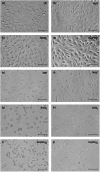In-vitro-cytotoxicity of cariostatic agents based on fluorides and lanthanide salts in L-929 fibroblasts
- PMID: 40593225
- PMCID: PMC12213984
- DOI: 10.1007/s00784-025-06429-8
In-vitro-cytotoxicity of cariostatic agents based on fluorides and lanthanide salts in L-929 fibroblasts
Abstract
Objectives: Fluoride-based cariostatic agents are commonly used in dental products and are generally considered safe. However, ongoing discussions about potential adverse effects are driving research into alternative agents, such as lanthanide salts. This study aims to evaluate the cytotoxic effects of different cariostatic agents, including fluoride compounds (NaF, Na2PO3F, NH4F) and lanthanide salts (Ce(NO3)3, CeCl3, Sm(NO3)3, SmCl3).
Materials and methods: Mouse fibroblasts (L-929) were cultured in Eagle's Minimum Essential Medium supplemented with 5% fetal bovine serum and 1% penicillin-streptomycin. Cell viability was assessed via MTT assay after 24 h of exposure to test compounds at concentrations of 0.0128, 0.064, 0.32, 1.6, 8, 40, 200 and 1000 mM, and lactate dehydrogenase (LDH) release was quantified to assess membrane integrity. The accumulation of reactive oxygen species (ROS) was determined after 24 h. Data were analyzed by non-parametric methods at a significance level of α = 0.05 (Mann-Whitney U and Kruskal-Wallis tests).
Results: Cell viability decreased significantly for NaCl and NaNO3 at 200 mM, and for NaF, NH4F, Ce(NO3)3, CeCl3, Sm(NO3)3 and SmCl3 at 1.6 mM, falling below 70% of control (P ≤ 0.0178). Similarly, LDH assays indicated a significant incline in cytotoxicity at a concentration of 200 mM for NaCl, NaNO3 and Na2PO3F, and at 8 mM for NaF, NH4F and all lanthanide compounds (P ≤ 0.0016). ROS quantification showed that NaF, NH4F, CeCl3, Sm(NO3)3 and SmCl3 induced oxidative stress at 1.6 mM with statistical significance (P ≤ 0.0065).
Conclusions: Fluoride and lanthanide compounds exhibited similar in vitro biocompatibility, comparable to that of table salt.
Clinical relevance: Both fluoride- and lanthanide-based cariostatic agents appear to pose a low biological risk to surrounding oral tissues when used at appropriate doses in dental products.
Keywords: Cariostatic agents; Cell death; Cell survival; Fluorides; Lanthanoid series elements; Toothpastes.
© 2025. The Author(s).
Conflict of interest statement
Declarations. Ethical approval: Not applicable. Conflict of interest: The authors have no competing interests to declare that are relevant to the content of this article.
Figures



Similar articles
-
Comparative assessment of biocompatibility of various fluoride agents in cell culture.BMC Oral Health. 2025 Jul 2;25(1):1009. doi: 10.1186/s12903-025-06496-z. BMC Oral Health. 2025. PMID: 40604900 Free PMC article.
-
Topical fluoride as a cause of dental fluorosis in children.Cochrane Database Syst Rev. 2024 Jun 20;6(6):CD007693. doi: 10.1002/14651858.CD007693.pub3. Cochrane Database Syst Rev. 2024. PMID: 38899538 Free PMC article.
-
Xylitol-containing products for preventing dental caries in children and adults.Cochrane Database Syst Rev. 2015 Mar 26;2015(3):CD010743. doi: 10.1002/14651858.CD010743.pub2. Cochrane Database Syst Rev. 2015. PMID: 25809586 Free PMC article.
-
Fluoride toothpastes of different concentrations for preventing dental caries in children and adolescents.Cochrane Database Syst Rev. 2010 Jan 20;(1):CD007868. doi: 10.1002/14651858.CD007868.pub2. Cochrane Database Syst Rev. 2010. Update in: Cochrane Database Syst Rev. 2019 Mar 04;3:CD007868. doi: 10.1002/14651858.CD007868.pub3. PMID: 20091655 Updated.
-
Triclosan/copolymer containing toothpastes for oral health.Cochrane Database Syst Rev. 2013 Dec 5;2013(12):CD010514. doi: 10.1002/14651858.CD010514.pub2. Cochrane Database Syst Rev. 2013. PMID: 24310847 Free PMC article.
References
-
- Larsen MJ (1990) Chemical events during tooth dissolution. J Dent Res 69:575–580. 10.1177/00220345900690S114 - PubMed
-
- Conrads G, About I (2018) Pathophysiology of dental caries. Monogr Oral Sci. S. 27:1–10. 10.1159/000487826 - PubMed
-
- Volker JF (1939) Effect of fluorine on solubility of enamel and dentin. Exp Biol Med 42:725–727. 10.3181/00379727-42-11029P
-
- Luoma H, Nykänen I, Seppä L et al (1989) Protection by F, I, sr, and combinations against fermentation attack by Streptococcus sobrinus artificial plaque on bovine enamel. Caries Res 23:5–13. 10.1159/000261147 - PubMed
-
- Rugg-Gunn A (2013) Fluoride toothpastes and fluoride mouthrinses. ActaMedAcad 42:168–178. 10.5644/ama2006-124.84 - PubMed
MeSH terms
Substances
LinkOut - more resources
Full Text Sources

